#kolyarut
Text


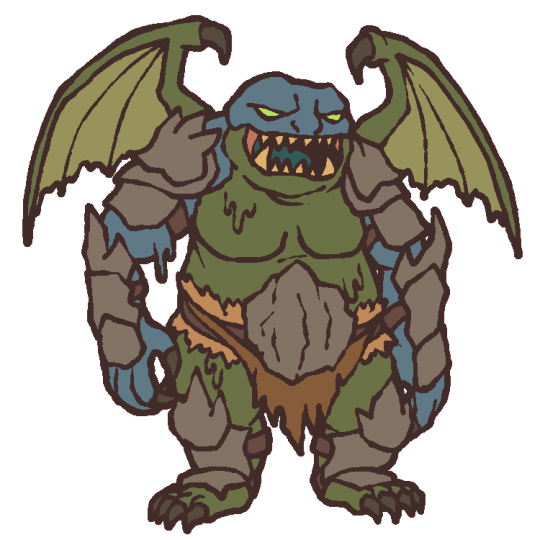
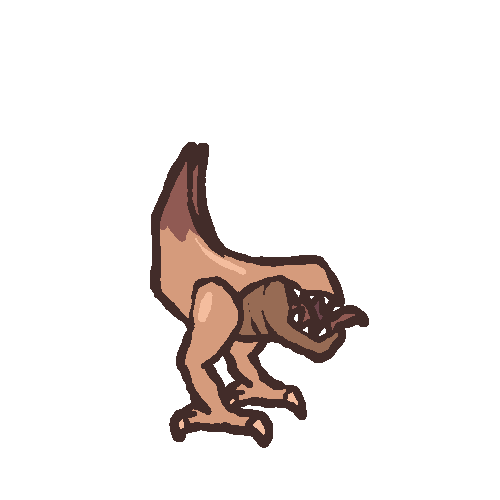




This time we've got some demons, a demodand, constructs, and everyone's favorite floating skull Morte.
Some of these, like the armanite or fluxcharger, have been on my to-draw list forever now, so it feels good to finally knock em out.
#d&d#pathfinder rpg#d&d 5e#d&d characters#character portraits#d&d minis#paper minis#demon#demodand#armanite#kelubar#kolyarut#inevitable#morte#abyssal chicken#fluxcharger
22 notes
·
View notes
Photo

Kolyarut
Medium construct (inevitable), lawful neutral
Armor Class 18 (plate)
Hit Points 161 (19d8 + 76)
Speed 30 ft.
Str 17, Dex 15, Con 19, Int 10, Wis 17, Cha 16
Saving Throws Dex +6, Int +4, Wis +7
Skills Perception +7, Insight +7, Investigation +4
Damage Immunities poison
Damage Resistances bludgeoning, piercing, and slashing from nonmagical attacks not made of adamantine
Condition Immunities charmed, exhaustion, frightened, paralyzed, petrified, poisoned
Senses darkvision 60 ft., passive Perception 17
Languages all
Challenge 12 (8400 XP)
Brute. A melee weapon deals one extra die of its damage when the kolyarut hits with it (included in the attack).
Discern Lies. The kolyarut knows if it hears a lie.
Immutable Form. The kolyarut is immune to any spell or effect that would alter its form.
Magic Resistance. The kolyarut has advantage on saving throws against spells and other magical effects.
Magic Weapons. The kolyarut's weapons are magical.
Innate Spellcasting. The kolyarut's spellcasting ability is Charisma (spell save DC 15). The kolyarut can innately cast the following spells, requiring no material components:
At will: disguise self, fear, invisibility, locate creature, suggestion
1/day each: geas, hold monster
Actions
Multiattack. The kolyarut makes three melee attacks or two ranged attacks. It can only make one Vampiric Touch attack per turn.
Longsword. Melee Weapon Attack: +7 to hit, reach 5 ft., one target. Hit: 12 (2d8+3) slashing damage or 14 (2d10+3) slashing damage if used with two hands, plus 9 (2d8) necrotic damage.
Vampiric Touch. Melee Spell Attack: +7 to hit, reach 5 ft., one creature. Hit: 24 (7d6) necrotic damage. The kolyarut regains hit points equal to half the amount of necrotic damage dealt.
Enervation Ray. Ranged Weapon Attack: +6 to hit, range 60 ft., one creature. Hit: 36 (8d8) necrotic damage and the target must succeed on a DC 16 Constitution saving throw or its hit point maximum is reduced by an amount equal to the damage taken. This reduction lasts until the target finishes a long rest. The target dies if this effect reduces its hit point maximum to 0.
Kolyaruts are among the inevitables, dispassionate but relentless enforcers of particular universal laws. Kolyaruts, in particular, hunt for those who break bargains or oaths. They are cautious in this pursuit, learning as much of their quarry as they can before setting out. They are more than willing to use their powers to disguise themselves to better close in on their prey. They are formal, polite, and quite talkative, but will not hesitate to use violence to subdue and punish their quarry.
Originally from the Monster Manual I.
#thirdtofifth CR 12#thirdtofifth construct#inevitable#d&d 5e#dnd 5e#dnd 3.5#d&d 3.5#dnd#d&d#dungeons and dragons#d&d homebrew#d&d monster
187 notes
·
View notes
Text
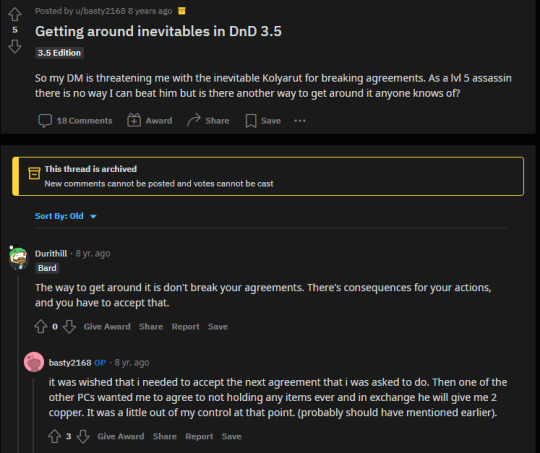
Saw this on Reddit when I was googling to see what deeper lore, or more varieties of Inevitables I could come up with for a character backstory.
Iunno if 5e uses Inevitables, but, basically, Inevitables are ...kinda cosmic justice robots. They come from Mechanus/whatever place represents Lawful Neutrality in a given setting, they're constructs, and there are a handful of canon types who each are tasked with enforcing law in some way. Zelekhuts enforce literal justice, think bounty hunters, maruts enforce the law that everything dies, there are inevitables who enforce causality and the sanctity of divinity, and the Kolyarut exists to punish those who break oaths and agreements.
Here's what the 3.5 SRD says about Kolyaruts-
Kolyaruts mete out punishment to those who break bargains and oaths.
Before beginning a mission against a deal-breaker, a kolyarut learns as much about the contract or oath as possible. It’s not interested in those who break deals accidentally or against their will— only those who willingly break contracts violate the principle that kolyaruts are created to uphold. If a written contract was broken, the kolyarut typically carries a copy of the contract with it.
Kolyaruts are the most talkative of the inevitables, making credible attempts at social niceties such as proper greetings before getting down to the matter at hand. They can use disguise self to appear as almost any kind of humanoid—useful if they need to go undercover to catch their quarry.
So.
First of all, the Reddit OP's "friends" are dicks. They would be fully justified in flipping them the double deuces and giving them a huge stink eye as they walk backwards out the door.
But, assuming someone were to find themselves in this position (and contrary to what some responders on the reddit post claim, wish can in fact force someone to agree to a deal, that's just duplicating the effects of dominate person), ...well, honestly, they should probably just leave, because that DM is not being reasonable, so it will come down to the PC fighting something seven levels above them.
*BUT*, assuming a reasonable DM, this could be a really interesting plot, assuming everyone was on board in the interest of telling cool stories.
Here's what we know-
-OP's character was magically compelled to accept a bad deal.
-Despite that compulsion, somehow, they broke the oath, and now a Kolyarut is on their trail.
-Kolyaruts, despite being, basically, contract lawyers from Hell, or perhaps because they are basically actually extreme contract lawyers, they are interested in having as complete a picture of the circumstances of the broken oath as possible.
-Kolyaruts are not interested in enforcing people who broke an oath against their own will, or otherwise did not voluntarily break their oath.
So, the thing for the player to do would be to reason with the kolyarut. This is an interesting case that will come down to judgement, because, technically, it seems, the PC broke the oath voluntarily. But they didn't make it voluntarily.
In real law, so far as I'm aware, generally, a contract signed, or oath sworn, under duress is considered void, invalid. It's going to vary by locality, but I believe that's fairly universal.
Of course, D&D doesn't necessarily operate on real law standards. But absent a DM telling you how the law, and especially cosmic ideals of law, work in their setting, it's a basis to work from.
Therefore, what the PC should do is, basically, sit and wait for the kolyarut to come to them, and then present the case that they were forced to make that oath. In real law, it is incumbent on the person who breached contract/oath that they were under duress when it was made. The PC would want to have some kind of evidence that they were magically compelled. They may only have witnesses, and those witnesses are probably just the other PCs involved, meaning they won't want to give honest testimony.
Unfortunately, kolyaruts cannot use zone of truth or the like, but they can use mark of justice. It would be reasonable for the kolyarut to put a mark of justice on the witnesses, with the trigger being "providing false witness when I ask you for testimony." This won't prevent the witnesses from lying, but it will cause them to suffer a bestow curse effect if they give false testimony, the kolyarut would know it triggered, and therefore, the kolyarut will know the witnesses gave false testimony. There is a slight problem here that a kolyarut can only use mark of justice once per day, which means multiple witnesses would need be handled over multiple days, but, eh, that's fine.
Now, this is where judgement comes in. By the SRD description of the kolyarut, they only disregard oaths that were broken unwillingly, not made. But, honestly, if people can be held to binding contracts and oaths made under duress, then the entire idea of lawful contracts falls apart, and therefore, personally, I feel a kolyarut, provided with compelling evidence that an oath was made under duress, would abandon their pursuit of the one who broke it. I also feel that the kolyarut would then consult with whoever the superiors of inevitables are about whether those who coerce others into making oaths are under their purpose's jurisdiction--and then show up again pursuing the person who made the wish and the one who took advantage of it. Possibly one or two zelekhuts in tow.
(now, I also wouldn't have this happen between PCs. The wisher and the one who took advantage of it would be recurring NPCs, but...)
15 notes
·
View notes
Photo
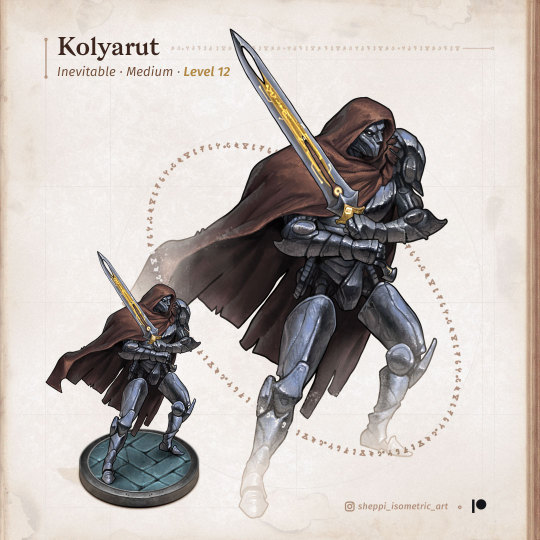
#dnd#pathfinder#tabletop#roll20#foundryvtt#dnd creature#dnd character#dnd monster#dungeons & dragons#isometric#dungeons and drawings#dnd homebrew#tabletop rpg#pathfinder character#rpg#roleplaying#fantasy monster#fantasy creature#kolyarut#inevitable#isometric token#enemy#monster#character#hero#level 12
25 notes
·
View notes
Photo

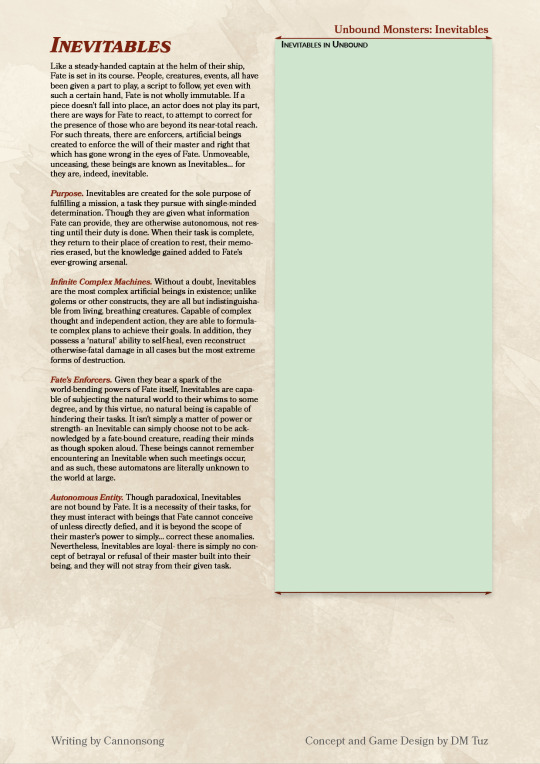
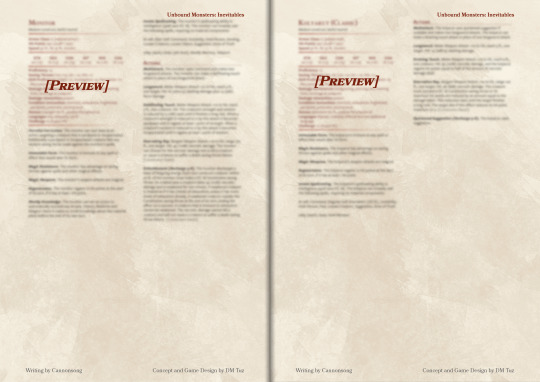

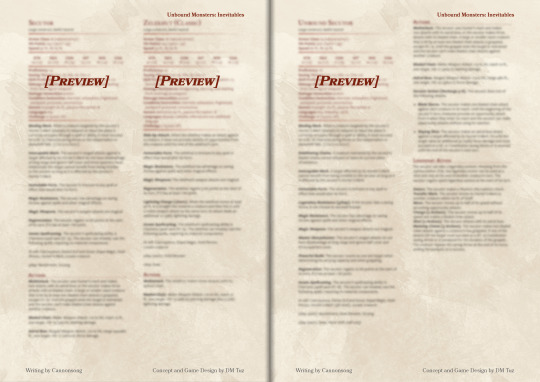
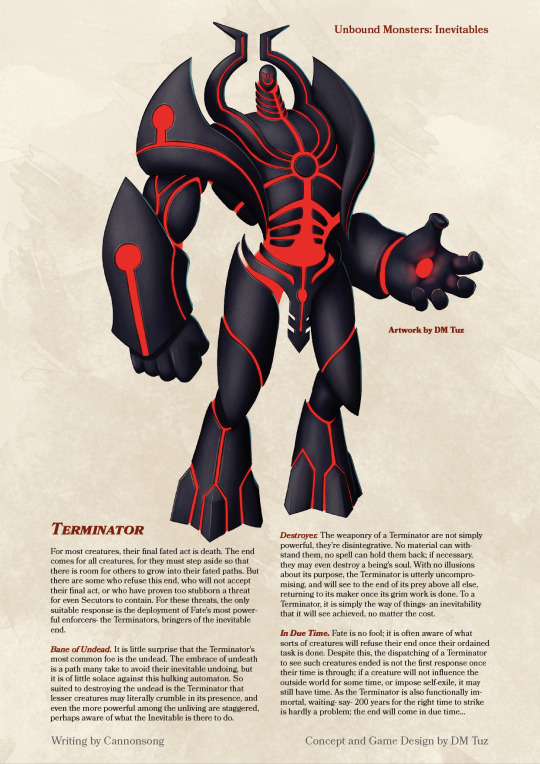
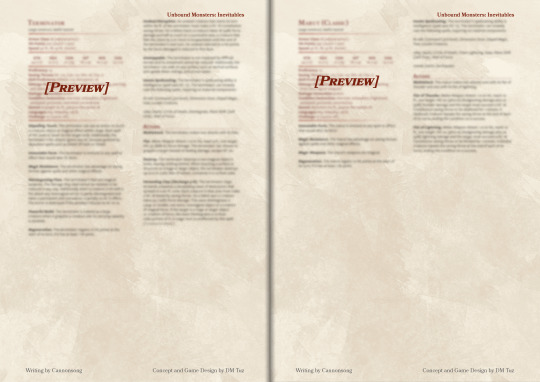
Unbound Monsters - Inevitables (Reimagined)
[More Unbound Monsters]
[DM Tuz Patreon]
[DM Tuz Twitter - stay updated on my current projects!]
#dm tuz#d&d#dnd 5e#monsters#homebrew#Unbound Monsters#dm tuz patreon exclusive#inevitables#marut#kolyarut#zelekhut#construct#fate
387 notes
·
View notes
Photo

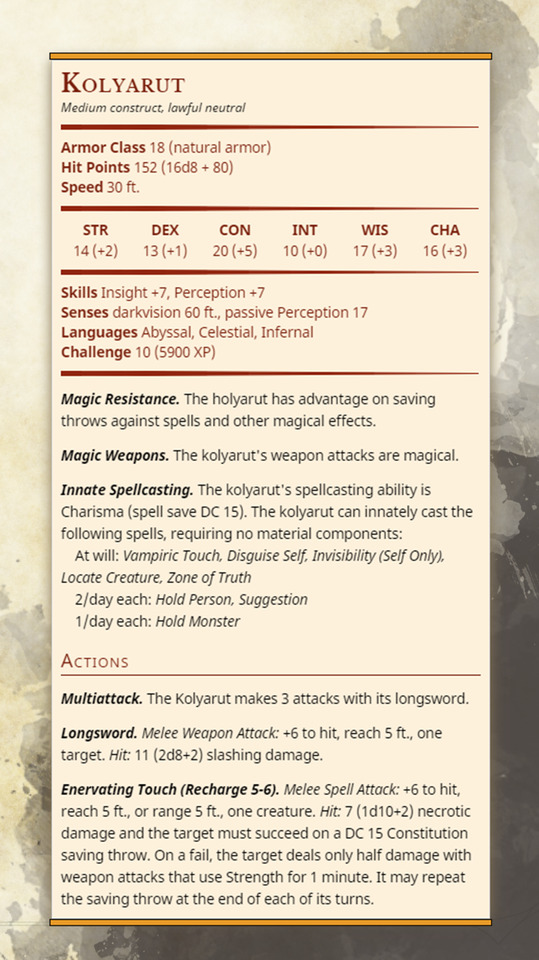
The first three inevitables, converted to 5e. They don’t have all of their abilities, but they should work better than nothing.
#inevitables#dnd#d&d#5e#5th edition#dungeons and dragons#marut#zelekhut#kolyarut#construct#lawful#mechanus#monsters#creatures#3.5e
338 notes
·
View notes
Text
Class Feature Friday: Greed Phantom (Spiritualist Emotional Foci)
A lot of things can tie a soul to the mortal plane, most often, it is strong emotion or trauma. However, some linger here because of obsession with a certain vice. Today, I present to you the first of a short series of “sin” phantoms from Occult Realms: The Greed Phantom.
In context of the Golarion Setting, sin phantoms represent a form of immortality sought out by certain mages in the ancient Thassalonian Empire, whose obsession with magic and the association it had with virtue and vice made the act of surviving one’s empire by becoming a phantom a tempting prospect.
Outside of that setting, however, sin phantoms might just be particularly sinful souls who never actually did anything condemning enough to cause them to rise as undead. As it stands, Occult Realms presents three sin phantoms, pointing out that the sins of wrath, sloth, and envy could simply be reskinned anger/hate, despair, and jealousy phantoms respectively. The only sin that doesn’t receive a sin phantom in some form is gluttony, due to its association with necromancy, and therefore, implying that the vast majority of gluttony-affiliated persons simply become undead. However, one could simulate a gluttony phantom with the necrologist archetype.
Regardless, greed phantoms are, by nature, beings of covetous desire, Wealth, power, or simply more of whatever they desired. While their ability to interact with such things is limited now, they know that they can still acquire such things using their spiritualist as a proxy. (Possibly a good use of the haunted archetype there)
Greed Phantoms are usually a golden or yellow color, or perhaps whatever color is most commonly associated with currency in the region they came from, and they often appear opulent, or make the sounds of jangling coins when moving.
As greedy individuals in life, it only makes sense that these phantoms are well-informed on things of great value, and can both appraise objects, as well as aid their spiritualist in identifying magic items.
Vicious and uncaring of life, particularly that which gets in the way of their desires, these phantoms strike with the intent to slay, their strikes having the potential to be particularly lethal.
Eager to take all that they can, these phantoms even absorb magical energy from the spells of their spiritualist, gaining the same effect as the spiritualist when they cast such a spell on themselves.
As an extension of that, these phantoms can even widen their magic-absorbing power, gaining the effects of the spells that others cast within a certain range.
Furthermore, these spectral misers are not content to just let strong magic go, and if defeated and forced back into the ether, these phantoms can use their spiritualists as a sort of magical coffer, transferring beneficial spells to them upon being banished, where they continue on until they run out, as normal.
Considering a buff-centric party? This phantom can benefit greatly, absorbing multitudes of buff spells from others even as they are being cast on other members of the party, or even stealing buffs from foes as well! I would consider a buffing spiritualist build, with a minor in combat, since they might end up having to face off against foes themselves as well.
Wealth and power are the name of the game for these phantoms, and they’ll be damned if a little thing like dying is going to keep them from what they want. As such, these phantoms may be overbearing and insistent on pursuing their goals, regardless of whether their spiritualist is haunted or not.
A treasure hunting expedition goes sour when the goblin hireling Bulpog accidentally dropped an ornate vase, causing the opulent greedy phantom of the tomb’s owner to break free, immediately possessing the first convenient vessel, Bulpog himself. How, the poor goblin has a very unpleasant tenant inside his head, demanding luxuries and bemoaning the lowly status of its host.
In life, a power broker for both mortal and outer affairs, the barrister Mackaron thought that dying would be the end of his latest contract with the forces of the beyond. Imagine his horror, then, to be reborn a phantom imbued with his own greed. Now he finds himself a target of psychopomps and marut inevitables on one side, and hunted by a team of kolyarut bounty hunters on the other.
Some say the Gilded Serpent is an exotic statue of a serpent coated in gemstones the way a reptile is covered in scales, some say it is something magical in nature, or a cult devoted to some obscure aspect of the snake god. In truth, however, the Gilded Serpent was a Nagaji woman who rose to power in the heyday of the naga empire, rivaling her serpentine creators in political power. Now, however, she lingers as an unfettered phantom, jealously guarding her past wealth.
#pathfinder#archetype#spiritualist#phantom#emotional foci#greed#goblin#inevitable#marut#kolyarut#psychopomp#nagaji#Occult Realms
16 notes
·
View notes
Text
D&D 3e>5e Conversion: Inevitables Part 1
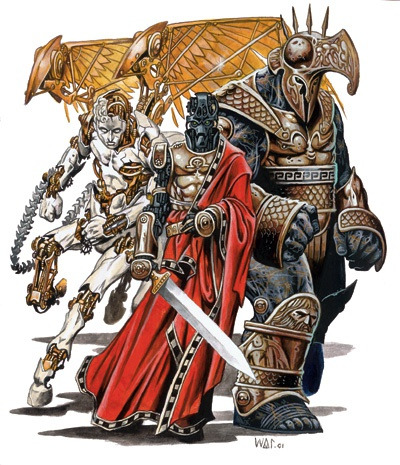
(from left) Zelekhut, Kolyarut, and Marut
Kolyarut
A kolyarut is shaped very closely to a humanoid. It wears ornate golden armor and a flowing golden robe and wields an immaculate blade. It could be mistaken for a human knight if it weren't for the red clockwork parts making up its facial features, and the fact that its armor is fused to itself.
Kolyaruts track down those who have deliberately broken a contract or deal they knowingly entered. They are most concerned with contracts that have great consequences when broken or contracts made between powerful beings.
They usually carry a copy of their target's contract with them and are highly formal and talkative compared to most inevitables.
Medium construct, lawful neutral
Armor Class: 16 (breastplate)
Hit Points: 178 (21d8 + 84)
Speed: 30 ft.
STR 16 (+3); DEX 13 (+1); CON 18 (+4); INT 10 (+0); WIS 17 (+3); CHA 16 (+3)
Saves: DEX +5, CON +8, WIS +7
Skills: Deception +7, Investigation +4, Insight +7
Damage Resistances: bludgeoning, piercing, and slashing damage from nonmagical weapons that aren't adamantine
Damage Immunities: poison, psychic
Condition Immunities: charmed, exhaustion, frightened, paralyzed, petrified, poisoned
Senses: darkvision 60 ft., passive Perception 13
Languages: All
Challenge: 12 (8,400 XP)
Magic Resistance. The kolyarut has advantage on saving throws against spells and magical effects.
Magic Weapons. The kolyarut's weapon attacks are magical.
Fast Healing. The kolyarut regains 5 hit points at the start of each of its turns as long as it has at least 1 hit point remaining.
Innate Spellcasting. The kolyarut's innate spellcasting ability is Charisma (spell save DC 15). The kolyarut can innately cast the following spells, requiring no material components:
At will: disguise self, fear, hold person, invisibility (self only), locate creature, suggestion
1/day each: bestow curse (7th level), hold monster
1/week: geas
Quickened Suggestion (3/Day). The kolyarut can use a bonus action during its turn to cast suggestion.
Actions
Multiattack. The kolyarut makes three longsword attacks and uses its vampiric touch.
Longsword. Melee Weapon Attack: +9 to hit, reach 5 ft., one target. Hit 9 (1d8 + 5) slashing damage, or 10 (1d10 + 5) slashing damage if using two hands.
Vampiric Touch. Melee Spell Attack: +7 to hit, reach 5 ft., one target. Hit 18 (4d8) necrotic damage. The kolyarut regains a number of hit points equal to half of the necrotic damage dealt.
Enervating Ray. One creature the kolyarut can see within 60 feet must make a DC 15 Constitution saving throw. A creature already under the effects of a kolyarut's enervating ray automatically succeeds on this save.
On a failed save, the creature gains three levels of exhaustion immediately. At the end of each of the creature's turns, it can make a new saving throw, shedding a level of exhaustion on a success. Once the creature succeeds at three such saves, the effect ends.
Reactions
Riposte. When a creature misses the kolyarut with a melee attack, the kolyarut can use its reaction to immediately make a longsword attack against that creature. On a hit, the attack deals an additional 5 (1d10) damage.
Marut
A marut looks like a hulking humanoid made from onyx-colored clockwork outfitted in elaborate golden armor. They have massive fists, one crackling with electricity and the other reverberating with a sonic hum.
Maruts hunt down creatures that have cheated death in some way. Perhaps another creature died in their place, or maybe they have extended their life through lichdom. Minor infractions like raising mindless undead are usually not on a marut's radar; they instead seek those who have changed their fated destiny to die. Only the marut knows the specifics of who deserves cosmic justice. When they discover such a crime, they hunt down the transgressor to bring them the death they escaped from.
Large construct, lawful neutral
Armor Class: 18 (plate armor)
Hit Points: 252 (24d10 + 120)
Speed: 40 ft.
STR 28 (+9); DEX 13 (+1); CON 20 (+5); INT 12 (+1); WIS 17 (+3) CHA 18 (+4)
Saves: DEX +6, CON +10, WIS +8
Skills: Athletics +14, Investigation +6, Insight +8, Persuasion +9, Perception +8, Religion +6
Damage Resistances: thunder, lightning; bludgeoning, piercing, and slashing damage from nonmagical weapons that aren't adamantine
Damage Immunities: poison, psychic
Condition Immunities: charmed, exhaustion, frightened, paralyzed, petrified, poisoned
Senses: darkvision 60 ft., passive Perception 13
Languages: All
Challenge: 15 (13,000 XP)
Awesome Blows. Each time the marut hits a creature of Medium or smaller size with a melee weapon attack, the creature must make a DC 18 Strength saving throw or be pushed 20 feet away from the marut and be knocked prone.
Magic Resistance. The marut has advantage on saving throws against spells and magical effects.
Magic Weapons. The marut's weapon attacks are magical.
Power Attack. The marut can reduce its attack bonus by 5 whenever it makes a melee weapon attack. If the attack hits, it deals a bonus 10 damage.
Fast Healing. The marut regains 10 hit points at the start of each of its turns as long as it has at least 1 hit point remaining.
Innate Spellcasting. The kolyarut's innate spellcasting ability is Charisma (spell save DC 15). The marut can innately cast the following spells, requiring no material components:
At will: dimension door, fear, command (3rd level), dispel magic, locate creature, true seeing
1/day each: bestow curse (9th level), chain lightning, circle of death, wall of force
1/week: earthquake, geas, plane shift
Actions
Multiattack. The marut makes two attacks, one with its fist of thunder and one with its fist of lightning.
Fist of Thunder. Melee Weapon Attack: +14 to hit, reach 10 ft., one target. Hit 16 (2d6 + 9) bludgeoning damage plus 10 (3d6) thunder damage. The target must make a DC 18 Constitution saving throw or become deafened until the start of the marut's next turn.
Fist of Lightning. Melee Weapon Attack: +14 to hit, reach 10 ft., one target. Hit 16 (2d6 + 9) bludgeoning damage plus 10 (3d6) lightning damage. The target must make a DC 18 Constitution saving throw or become blinded until the start of the marut's next turn.
Zelekhut
A zelekhut appears to be a clockwork centaur with ornate golden armor over porcelain skin. When entering combat with its intended target, it sprouts golden wings from its back and spiked golden chains from its wrists that crackle with electricity.
Zelekhuts hunt down those who try to escape punishment or disrupt justice. They are highly adept at finding their targets using both their tracking instincts as well as spells. Inevitably, they will find their mark and either mete out justice or bring them back to whatever fate they were fleeing.
Large construct, lawful neutral
Armor Class: 16 (natural armor)
Hit Points: 104 (11d10 + 44)
Speed: 40 ft., fly 40 ft.
STR 21 (+5); DEX 11 (+0); CON 18 (+4); INT 10 (+0); WIS 17 (+3); CHA 15 (+2)
Saves: DEX +4, CON +8, WIS +7
Skills: Investigation +4, Insight +7, Perception +7, Survival +7
Damage Resistances: lightning, bludgeoning, piercing, and slashing damage from nonmagical weapons that aren't adamantine
Damage Immunities: poison, psychic
Condition Immunities: charmed, exhaustion, frightened, paralyzed, petrified, poisoned
Senses: darkvision 60 ft., passive Perception 17
Languages: All
Challenge: 9 (5,000 XP)
Charge. If the zelekhut moves at least 30 feet straight toward a target and then hits it with a stomp attack on the same turn, the target takes an extra 10 (3d6) bludgeoning damage.
Magic Resistance. The zelekhut has advantage on saving throws against spells and magical effects.
Magic Weapons. The zelekhut's weapon attacks are magical.
Fast Healing. The zelekhut regains 5 hit points at the start of each of its turns as long as it has at least 1 hit point remaining.
Innate Spellcasting. The zelekhut's innate spellcasting ability is Charisma (spell save DC 16). The zelekhut can innately cast the following spells, requiring no material components:
At will: clairvoyance, dispel magic, fear, hold person, hunter's mark, locate creature, true seeing
3/day each: bestow curse (5th level), hold monster
1/week: geas
Actions
Multiattack. The zelekhut makes two spiked chain attacks and one stomp attack.
Spiked Chain. Melee Weapon Attack: +9 to hit, reach 10 ft., one target. Hit 12 (2d6 + 5) piercing damage plus 3 (1d6) lightning damage.
Stomp. Melee Weapon Attack: +9 to hit, reach 5 ft., one target. Hit 14 (2d8 + 5) bludgeoning damage. The target must make a DC 16 Strength saving throw or be knocked prone.
246 notes
·
View notes
Text
My Changes to “Way of the Wicked“, Extras 3: Extraplanar Hunters
I kind of had the first one in the back of my mind for a while, but always forgot to put it down on paper, but thanks to vlogger Dungeon Dad converting a bunch of old 3.5 and Pathfinder 1e monsters to 5e, I was reminded that these creatures were very different in 3.5 compared to Pathfinder, and why I had originally considering at least the inevitable for this adventure path.
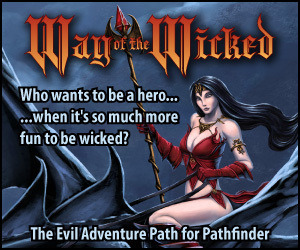
As always, for space reasons, I’ll be cropping the encounter build.
I do not have a Patreon or a Kickstarter, but I do have a Ko-Fi page (linked) for those who would like to support my work. There is no pressure or obligation to do so, however, but a like and a share would definitely be appreciated. Of this and my older work.
Just before get to it, I hope everyone’s staying safe right now.
There are three sets of stats this time around, and two of them are actually one NPC; a hound archon and his dragon mount. More on that later, including a description regarding how the concept exists. This is what I was talking in the last entry regarding this being something that was skipped over in the Pathfinder bestiary from its 3.5 version.
I’ll say for starters, I didn’t give the NPCs any traits. Those are for PCs, more often than not, but admittedly that was a staple of Gary’s builds to try make the NPCs able to stand up to the villains more. It also felt like an in-joke that the NPCs were the heroic PCs all along. If you want to give them one trait, that’s fine, but for these ones, I didn’t feel it was overly necessary to do so. The only one I even considered was the hound archon, and only to give him armor expert to negate the final armor check penalty to skills.
For starters, inevitables are the very definition of law. Each one has a specific mandate for how things should or shouldn’t be, and how everything interacts with the multiverse.
For starters, we have a zelekhuts are defined as “ bounty hunters and executioners all rolled into one.” The PCs were supposed to die or at least be judged and sent to the salt mines. They escaped. That needs to be rectified. By all means, you can use the standard CR 9 version and have it appear during Book 2, but mine is slightly different. More so because in Book 2, unless you’re doing this incredibly early, the villains may have already amassed a literal army, if only undead. A CR 9 inevitable isn’t going to cut it. My version would appear much later, and it’s also a little different from your regular zelekhut.
I’ll say now, that the reason Judiceye is a variant is because most zelekhuts would just arrive and rain down lawful smiting on their chosen to die. But this one is more crafty. Mitra has seen what the villains can do, and how devious they are, not to mention how large their ever growing army has become. This particular zelekhut’s duty is to show up at the end of Book 3, during the winter months, free any and all prisoners as best as it can, and cause in-fighting among the bugbears and other riffraff that have joined the 9th Knot. If it can take out some unwanted undead, all the better. The PCs are supposed to lose a portion of their troops at the end of winter anyhow due to them running away and leaving their minions high and dry, so this just furthers that plot line all the while putting the PCs on edge. There’s either a traitor among them or maybe the villains just can’t control their people, showing just how unfit they are. And if they start executing their own men for not listening when it’s really just the zelekhut? All the better to use as kindling to create riots and arguments, and really give the villains a run for their money. It’d make for a long winter indeed. And right before the king shows up, or whenever the time is right in the GM’s mind, and the Knot is near their breaking point (possibly when there’s the most confusion), the zelekhut can start a major brawl and try its luck in taking out the PCs. Even better, with its greater hat of disguise, it can change itself to look like whomever it needs to. Just needs Intel first. It can be a PC, a bugbear, a vampire, the medusa half-fiend, or whoever. Doesn’t matter. Because it start a fight, then leave, and turn into someone else. Whatever needs to be done to take down the PCs.
I will not that the DD for the elemental combat style is from the Pathfinder Disciple's Doctrine. Normally I would go OGL and Core, but this time I need some extra damage, and this was about the only way to pull it off. Also, the reason the hat’s trapped is because these things aren’t supposed to normally have treasure. This will destroy the treasure and maybe do some damage to the PCs at the same time.

JUDICEYE (CR 16; XP 76,800)
Variant advanced zelekhut ranger (guildbreakerUI) 7
LN Large outsider (extraplanar, inevitable, lawful)
Init +11; Senses darkvision 60 ft., low-light vision, true seeing; Perception +25
DEFENSE
AC 31, touch 17, flat-footed 23 (+1 armor, +7 Dex, +1 dodge, +13 natural, –1 size)
hp 236 (21d10+121); regeneration 5 (chaotic)
Fort +18, Ref +16, Will +15
Defensive Abilities constructed; DR 10/chaotic, DR 3/— (small ranged piercing weapons); SR 27
OFFENSE
Speed 50 ft., fly 60 ft. (average)
Melee 2 chains +31 (3d6+10/19–20 plus 1d6 electricity and trip)
Space 10 ft.; Reach 10 ft.
Special Attacks favored enemy (goblinoids +2), favored organization (Knots of Asmodeus +4)
Spell-Like Abilities (CL 14th; concentration +18)
Constant—true seeing
At will—clairaudience/clairvoyance, dimensional anchor, dispel magic, fear (W-DC 18), hold person (W-DC 17), locate creature
3/day—hold monster (W-DC 19), mark of justice
1/week—lesser geas (W-DC 17)
Ranger Spells Prepared (CL 4th; concentration +8)
2nd—chameleon stride
1st—lead blades, resist energy
STATISTICS
Str 30, Dex 24, Con 18, Int 10, Wis 18, Cha 18
Base Atk +21; CMB +32; CMD 50 (54 vs. trip)
Feats Combat Reflexes, Dodge, EnduranceB, Improved Critical (chains), Improved Initiative, Improved Natural Attack (chains), Improved Vital Strike, Inner FlameARG, Mobility, Power Attack, Scorching WeaponsARG, Step Up, Weapon Focus (chain), Vital Strike
Skills Acrobatics +25 (+33 jump), Bluff +15, Disguise +15, Diplomacy +17, Fly +19, Knowledge (local) +10, Knowledge (planes) +13, Perception +25, Sense Motive +21, Spellcraft +11, Stealth +21, Survival +17; Racial Modifiers +4 Perception, +4 Sense Motive
Languages truespeech
SQ chains, combat style (elementalDD), crowd stride, deep cover, favored terrain (urban +2), read the cityUI, track +3
Gear quilted clothUE, greater hat of disguise (trapped: maximized fireball; 60 fire damage, R-DC 19)
SPECIAL ABILITIES
Chains (Ex) A zelekhut’s arms end in long lengths of barbed metal. These chains deal slashing damage and 1d6 points of electricity damage with each hit.
Constructed (Ex) Although inevitables are living outsiders, their bodies are constructed of physical components, and in many ways they function as constructs. For the purposes of effects targeting creatures by type (such as a ranger’s favored enemy and bane weapons), inevitables count as both outsiders and constructs. They are immune to death effects, disease, mind-affecting effects, necromancy effects, paralysis, poison, sleep, stun, and any effect that requires a Fortitude save (unless the effect also works on objects, or is harmless). Inevitables are not subject to nonlethal damage, ability damage, ability drain, fatigue, exhaustion, or energy drain. They are not at risk of death from massive damage. They have bonus hit points as constructs of their size.
Catching up on a few posts from GMs and players who are going through “Way of the Wicked”, most groups are having no issue whatsoever with the AP because they have a necromancer and a cleric who are creating epic armies of undead. That said, there have been one or two groups that have found themselves struggling, if only because they never rescued Grumblejack, or he died on them back during Branderscar because they all bailed and abandoned the ogre. As such, they’re finding that as the game is progressing, they’re having issues. I’ve got something to help potentially counteract that, if only for one part of the book.
It’s a Book 5 add-on that I thought of. Marut inevitables go after those who artificially extend their life. Namely, lichdom. Now, depending on the PCs, this could be yet another encounter for them too. If they’re using the feat tree that turns them into a vampire or lich, or they all became vampires in the alternate version of the story where Thorn’s a vampire, this thing’s coming after them. There’s just no way around that. However, my initial thought for this, so as to help parties that are having troubles, is the marut came to take down the now ex-Cardinal Thorn, but was dominated and sent after the party. This encounter would take place on the main floor, probably as soon as the PCs entered the cathedral. If the PCs have the means, they could break the control and have it join them in the final battle against Thorn. But you’re asking, “how can Thorn use that spell? It’s not a cleric spell and it’s 9th level.” It’s also a 6th level summoner spell, so miracle would work to cast it. This would reduce Thorn’s 9th level spells by 1, and hopefully that’s enough for the PCs who are struggling. After that though, the marut would leave, its mission completed.
Finally, my last inevitable add-on, and this would be for whenever someone in the party broke a contract (or someone attached to the party, etc). It can even be someone the party is dealing with, who broke a contract, and they summon one to go after that person/creature. The kolyarut is all about negotiating bargains, and they don’t like it when contracts and negotiations break down. They punish all oath-breakers. As stated: “They care little for the terms of the agreements in question, only that promises are fulfilled, debts are paid, and balance is maintained.“ They are definitely someone that the PCs want on their side. Pit fiends and contract devils are great, but they don’t necessarily like to get their hands dirty. They just want souls and payment. Kolyaruts, on the other hand, will always make the time.
-------------------------------------
And now, the ultimate combo that’s just bonkers. I even did a small feat sink on this one despite it actually being something in the original edition that happens for free, and just adds to the CR.
As for where you would encounter this one, there’s any number of ways.
1) Could be a fight not long after they finish Book 3. Mitra might send the archon as an avenger for what happened.
2) Could right after Spring arrives and the villains are fleeing from the king and his army. This could either be an air battle or the very second they land, but before Tiadora arrives.
3) They could arrive with any other encounter, boosting the over all combat and aiding whomever else decides to attack the villains. You could even hold out until Book 6 with this one, if you really wanted to.
The monster info on this variant hound archon reads as thus:
Hound Archon Hero Mounts
In the course of their adventures, many hound archon heroes befriend bronze dragons, which may come to serve as their mounts. The relationship between these mounts and their celestial riders goes beyond even the special bond between paladin and mount. The dragon and the archon are naturally allies and friends, as can be expected of two powerful servants of cosmic justice. The juvenile bronze dragon mount gains 2 additional HD, 4 points of Strength, an additional 4 points of natural armor, improved evasion, and +10 feet to speed in all its movement forms. The dragon cannot, however, command other creatures of its type as other kinds of paladin mounts can.
Note: Under normal circumstances the Draconic Companion from the Dragon Companion Handbook would give you a dragon and have it go up as an animal companion, with the Dragon Companion Mastery feat giving you their full power. Hound Archon Heroes already get an equivalent ability for free so I’m revising the feat to instead give: frightful presence 1/day, +2 Dex instead of +2 Str (which is a swap option you can choose), SR 5 + paladin level, share spells, empathic link, and two of the four bonus dragon feats. However, I’m ignoring the other two bonus feats the dragon would normally gain, additional bonuses to Str/Con/natural armor, and standard ability score increases every 4 Hit Die. The trade off being that a standard bronze dragon has higher mental stats and spells, so it easily balances out.
Overall, this not all that different from the 3.5 Monster Manual version, and should be considered a difficult CR 16 encounter. Also, their wealth is for a CR 16 NPC. Bartel shares it with his dragon mount.

BARTEL, THE HOUND ARCHON HERO (CR 16; XP 76,800)
Male Advanced variant hound archon paladin 11
LG Medium outsider (archon, extraplanar, good, lawful)
Init +6; Senses darkvision 60 ft., detect evil, low-light vision, scent; Perception +18
Aura courage (10 ft.), justice (10 ft.), menace (20 ft.; W-DC 21), magic circle against evil, resolve (10 ft.)
DEFENSE
AC 33, touch 12, flat-footed 31 (+9 armor, +2 Dex, +12 natural); +2 deflection vs. evil
hp 229 (19 HD; 19d10+125)
Fort +24, Ref +16, Will +21; +4 vs. poison, +2 resistance vs. evil
DR 10/evil; Immune charm, disease, electricity, fear, petrification; SR 27
OFFENSE
Speed 40 ft.
Melee +2 cold iron greatsword +29/+24/+19/+14 (2d6+12/17–20), bite +22 (1d8+4) or
bite +27 (1d8+8), slam +27 (1d4+4)
Special Attacks channel energy (W-DC 20, 6d6), smite evil 4/day (+5 atk & AC, +11 dmg)
Spell-Like Abilities (CL 6th; concentration +11)
Constant—detect evil, magic circle against evil
At will—aid, continual flame, greater teleport (self plus 50 lbs. of objects only), message
Paladin Spell-Like Abilities (CL 11th; concentration +16)
At will—detect evil
Paladin Spells Prepared (CL 8th; concentration +13)
3rd—heal mount
2nd—bull’s strength, eagle’s splendor, resist energy
1st—divine favor, hero’s defianceAPG, protection from evil, shield of fortificationACG
STATISTICS
Str 24, Dex 14, Con 22, Int 12, Wis 20, Cha 20
Base Atk +19; CMB +26; CMD 38; +2 vs. evil
Feats Blind-Fight, Draconic CompanionDCH, Improved Critical (greatsword), Improved Initiative, Iron Will, Mounted Combat, Power Attack, Ride-by Attack, Weapon Focus (greatsword), Word of HealingUM
Skills Acrobatics +14, Diplomacy +19, Knowledge (arcana) +12, Intimidate +15, Perception +18, Ride +18, Sense Motive +19, Spellcraft +10, Stealth +14, Survival +18; Racial Modifiers +4 Stealth, +4 Survival; ACP –1
Languages Celestial, Draconic, Infernal; truespeech
SQ aura (overwhelming good), code of conduct, change shape (beast shape II), divine bond (dragon mount; Arlakaida), lay on hands (5d6, 7/day), mercies (cursed, dazed, fatigued)
Combat Gear wand of cure light wounds (15 charges), holy water (2); Other Gear +3 mithral breastplate, +2 cold iron greatsword, amulet of mighty fists +1, belt of mighty constitution +2
SPECIAL ABILITIES
Aura of Menace (Su) A righteous aura surrounds archons that fight or get angry. Any hostile creature within a 20-foot radius of an archon must succeed on a Will save to resist its effects. The save DC varies with the type of archon, is Charisma-based, and includes a +2 racial bonus. Those who fail take a –2 penalty on attacks, AC, and saves for 24 hours or until they successfully hit the archon that generated the aura. A creature that has resisted or broken the effect cannot be affected again by the same archon’s aura for 24 hours.
Change Shape (Su) A hound archon can assume any canine form of Small to Large size, as if using beast shape II. While in canine form, the hound archon loses its bite, slam, and greatsword attacks, but gains the bite attack of the form it chooses. For the purposes of this ability, canines include any dog-like or wolf-like creature of the animal type.
---------------
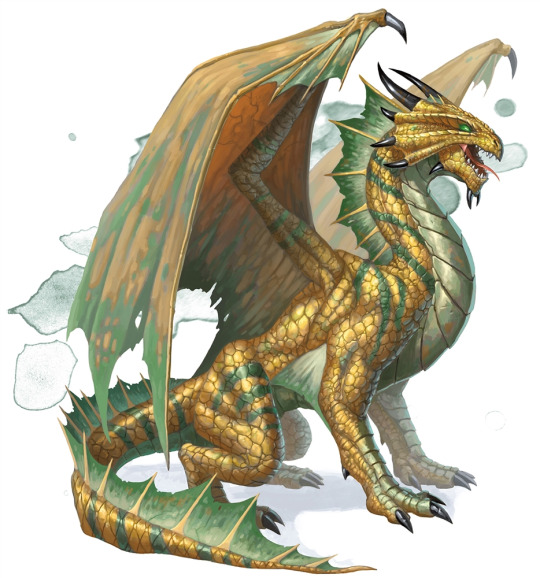
ARLAKAIDA THE BRONZE (CR —; XP —)
Female juvenile bronze dragon
LG Large dragon (water)
Init +6; Senses dragon senses; Perception +25
Aura frightful presence 1/day (90 ft.; targets are shaken for 14 rounds; W-DC 21)
DEFENSE
AC 36, touch 13, flat-footed 33 (+5 armor, +2 Dex, +2 deflection, +18 natural, –1 size)
hp 161 (14d12+70)
Fort +16, Ref +13, Will +15
Defensive Abilities improved evasion; Immune electricity, paralysis, sleep; SR 16
OFFENSE
Speed 50 ft., fly 130 ft. (poor), swim 60 ft.
Melee bite +25 (2d6+15), 2 claws +24 (1d8+11), tail slap +22 (1d8+15), 2 wings +22 (1d6+6)
Space 10 ft.; Reach 5 ft. (10 ft. with bite)
Special Attacks breath weapon (80-ft. line, R-DC 24, 12d6 electricity), repulsion breath
Spell-Like Abilities (CL 14th; concentration +18)
At will—create food and water, speak with animals
Sorcerer Spells Known (CL 4th; concentration +8)
2nd (4/day)—mirror image
1st (7/day)—alarm, obscuring mist, true strike
0 (at will)—detect magic, light, mage hand, message, prestidigitation, resistance
STATISTICS
Str 29, Dex 14, Con 21, Int 18, Wis 19, Cha 18
Base Atk +14; CMB +26; CMD 40 (44 vs. trip)
Feats Ability Focus (breath weapon), Alertness, Flyby Attack, Improved Initiative, Multiattack, Powerful BreathB, Quick Breath WeaponB, Vital Strike, Weapon Focus (bite)
Skills Diplomacy +19, Fly +12, Handle Animal +16, Heal +16, Intimidate +19, Knowledge (arcana) +19, Perception +25, Sense Motive +25, Spellcraft +20, Stealth +14, Swim +29; Racial Modifiers +8 Swim
Languages Aquan, Common, Draconic, Elven, Gnome
SQ empathic link, change shape (animal or humanoid, polymorph), share spells, water breathing, wave mastery (40 mins)
Gear +2 studded leather barding, amulet of mighty fists +2, belt of physical perfection +2, cloak of resistance +2, ring of protection +2
SPECIAL ABILITIES
Dragon Senses (Ex) Dragons have darkvision 120 ft. and blindsense 60 ft. They see four times as well as a human in dim light and twice as well in normal light.
Frightful Presence (Ex) This special quality makes a dragon’s very presence unsettling to foes. Activating this ability is a free action that is usually part of an attack or charge. This ability affects only opponents with fewer Hit Dice than the dragon’s. An opponent that succeeds on its saving throw is immune to the dragon’s frightful presence for 24 hours. Multiple uses of a dragon’s presence don’t stack. This ability is a mind-affecting aura.
Paladin Mount (Ex) Arlakaida cannot command other creatures of its type (bronze dragons) as other kinds of paladin mounts can.
Quick Breath Weapon (Ex) Arlakaida is able to unleash her breath weapon and deliver an attack before her opponent is the wiser. On her turn, Arlakaida can choose to use her breath weapon in place of her bite or one of her claw attacks.
Repulsion Breath (Su) Instead of a line of electricity, a bronze dragon can breathe a cone of repulsion gas. Targets must make a Will save or be compelled to do nothing but move away from the dragon for 1d6 rounds plus 1 round per age category. This is a mind-affecting compulsion effect.
Water Breathing (Ex) A bronze dragon breathes water and can use its breath weapon, spells, and abilities underwater.
Wave Mastery (Su) For up to 10 minutes per age category per day, a juvenile bronze dragon, along with creatures or vessels within 50 feet, can move at twice its normal speed in water.
------------------------------------------------------------
And that’s everything. I don’t know that I’ll ever have more to add to this particular adventure path, but maybe I will. Just depends on how inspired I get.
In the meantime, I hope everyone who is running or playing “Way of the Wicked” is having a fantastic time.
#Way Of The Wicked#the villains win#the bad guys win#pathfinder#pathfinder 1e#pathfinder rpg#adventure path#gary mcbride#fire mountain games#pathfinder roleplaying game#D&D#dnd#dungeons & dragons#Dungeons and Dragons#ttrpg#d20#Book 4#Book 5#encounters#monsters#villains#evil campaign#add-ons#Book 6
1 note
·
View note
Photo

Please enjoy this picture from Concordance of Rivals (pg 4) in which we see the Monitors engaged in their usual pastime of relentlessly arguing with one another as Pharasma checks her watch to see how much longer she has to put up with this nonsense.
Left to right: Kolyarut Inevitable, a Pleroma Aeon*, Nosoi Psychopomp, Keketar Protean.
*I think? None of the other Aeons are even remotely humanoid, aside from the many-armed Lipika.
29 notes
·
View notes
Text
Eberron Planar Monster (Bestiary 2)
Here’s something that has been sitting in my drafts forever. I just did some touch ups on it since Keith just posted a couple of articles on Eberron’s Planes.
All Planes
Aeon, Akhana
Aeon, Bythos
Aeon, Paracletus
Aeon, Pleroma
Aeon, Theletos
Inevitable, Lhaksharut
Astral Plane
Daemon, Astradaemon*
Daemon, Thanadaemon*
Dragon Horse*
Daanvi, the Perfect Order
Axiomite
Devil, Belier
Inevitable, Arbiter
Inevitable, Kolyarut
Inevitable, Zelekhut
Dal Quor, the Region of Dreams
Animate Dream
Wendigo*
Dolurrh, the Realm of the Dead
Daemon, Astradaemon
Daemon, Cacodaemon
Daemon, Thanadaemon
Demon, Kalavakus
Inevitable, Marut
Petitioner
Soul Eater
Ethereal Plane
Daemon, Thanadaemon*
Dragon Horse*
Fernia, the Sea of Fire
Azata, Brijidine
Azer
Devil, Immolation
Dragon, Magma
Elemental, Magma
Magma Ooze
Rast
Thoqqua
Irian, the Eternal Day
Archon, Star
Jyoti
Shining Child
Kythri, the Churning Chaos
Chaos Beast
Elemental, Lightning
Howler
Protean, Imentesh
Protean, Keketar
Protean, Naunet
Protean, Voidworm
Titan, Elysian
Titan, Thanatotic
Lamannia, the Twilight Forest
Achaierai
Agathion, Avoral
Agathion, Cetaceal
Agathion, Draconal
Agathion, Leonal
Agathion, Silvanshee
Agathion, Vulpinal
Amoebas (all)
Badgers (all)
Bats (all)
Bees (all)
Beetles (all)
Belker
Camel
Centipedes (all)
Cockroaches (all)
Crysmal
Demon, Omox
Dinosaur, Allosaurus
Dinosaur, Compsognathus
Dinosaur, Parasaurolophus
Dinosaur, Tylosaurus
Dragon, Brine
Dragon, Cloud
Dragon, Crystal
Dragonfly, Giant
Elemental, Mud
Fly, Giant
Maggot, Giant
Gars (all)
Hellcat
Hippopotami (all)
Lycanthrope, Werebear
Lycanthrope, Wereboar
Lycanthrope, Weretiger
Mandragora
Megafauna, Arsinoitherium
Megafauna, Glyptodon
Megafauna, Megaloceros
Megafauna, Megatherium
Mihstu
Moonflower
Mosquitos (all)
Pech
Phycomid
Primates (all)
Qlippoth, Cythnigot
Quickwood
Ram
Rays (all)
Sandman
Scorpions (all)
Snakes (all)
Solifugids (all)
Spiders (all)
Tendriculos
Ticks (all)
Toads (all)
Turtles (all)
Vipervine
Whales (all)
Xacarba
Xtaby
Mabar, the Endless Night
Bodak
Daemon, Astradaemon
Daemon, Ceustodaemon
Daemon, Derghodaemon
Daemon, Hydrodaemon
Daemon, Leukodaemon
Daemon, Meladaemon
Daemon, Olethrodaemon
Daemon, Piscodaemon
Daemon, Purrodaemon
Daemon, Thanadaemon
Demon, Vrolikai
Dragon, Umbral
Nightshade, Nightcrawler
Nightshade, Nightwalker
Nightshade, Nightwave
Nightshade, Nightwing
Sceaduinar
Plane of Shadows
Dragon, Umbral
D'ziriak
Gloomwing
Mothman*
Tenebrous Worm
Risia, the Plane of Ice
Elemental, Ice
Wendigo
Shavarath, the Battleground
Archon, Shield
Demon, Shemhzaian
Devil, Accuser
Devil, Handmaiden
Syrania, the Azure Sky
Angel, Cassisian
Angel, Monadic Deva
Angel, Movanic Deva
Mercane
Thelanis, the Faerie Court
Azata, Lyrakien
Brownie
Forlarren
Gremlin, Jinkin
Gremlin, Nuglub
Gremlin, Pugwampi
Gremlin, Vexgit
Grig
Jabberwock
Kelpie
Korred
Leprechaun
Lurker in the Light
Nereid
Quickling
Redcap
Sard
Thrasfyr
Triton
Twigjack
Xoriat, the Realm of Madness
Denizen of Leng
Hound of Tindalos
Leng Spider
Mu Spore
Neh-Thalggu
Qlippoth, Augnagar
Qlippoth, Chernobue
Qlippoth, Iathavos
Qlippoth, Nyogoth
Qlippoth, Shoggti
Qlippoth, Thulgant
* Not native to this plane, but can travel there using spell-like or supernatural abilities
11 notes
·
View notes
Photo
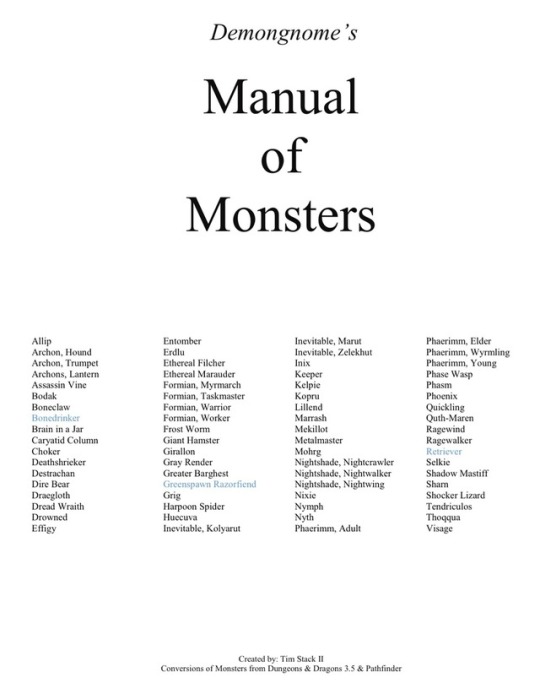
This Reddit thread led me to Demongnome’s Manual of Monsters. Sixty nine monster conversions from 3.0, 3.5 and Pathfinder. The converted monsters are listed below.
Allip
Archon, Hound
Archon, Trumpet
Archons, Lantern
Assassin Vine
Bodak
Boneclaw
Bonedrinker
Brain in a Jar
Caryatid Column
Choker
Deathshrieker
Destrachan
Dire Bear
Draegloth
Dread Wraith
Drowned
Effigy
Entomber
Erdlu
Ethereal Filcher
Ethereal Marauder
Formian, Myrmarch
Formian, Taskmaster
Formian, Warrior
Formian, Worker
Frost Worm
Giant Hamster
Girallon
Gray Render
Greater Barghest
Greenspawn Razorfiend
Grig
Harpoon Spider
Huecuva
Inevitable, Kolyarut
Inevitable, Marut
Inevitable, Zelekhut
Inix
Keeper
Kelpie
Kopru
Lillend
Marrash
Mekillot
Metalmaster
Mohrg
Nightshade, Nightcrawler
Nightshade, Nightwalker
Nightshade, Nightwing
Nixie
Nymph
Nyth
Phaerimm, Adult
Phaerimm, Elder
Phaerimm, Wyrmling
Phaerimm, Young
Phase Wasp
Phasm
Phoenix
Quickling
Quth-Maren
Ragewind
Ragewalker
Retriever
Selkie
Shadow Mastiff
Sharn
Shocker Lizard
Tendriculos
Thoqqua
Visage
#dungeons & dragons#dungeons and dragons#DnD#D&D#5e#d&d 5th edition#Monster#monster stats#monster conversion#gray render#demongnome#demongnome's Manual of Monsters
942 notes
·
View notes
Text
Excerpts From the Journal Of Praefectus
Waking up from reprogramming was, for lack of a better phrase, off-putting. Since my creation, I had a drive to ensure that contracts are fulfilled, and moving from one target to the next. When I woke up, I remembered feeling that driving force behind my every move, but it was very much a lost feeling to me. Dwarven healers have tried to relate it to the loss of purpose that mortals feel in bouts of anxiety and depression, but, that doesn’t seem right to me. It’s more like the psychological equivalent to phantom limb pain. The drive is long gone, but, the sensation that I have a contract related task occasionally recurs.
Rion, the satyr that reprogrammed me, suggested I find some way to focus my energy elsewhere. Conveniently, he had removed my legs during my reprogramming to keep me from running. He handed me a few tomes on mechanical engineering and told me I was free to do as I wished. It’s hard to do anything without mobility; so, I put myself back together, allowing my mind to focus on the task at hand. Despite several roadblocks, I made myself physically whole, but without that initial programming, I was at a loss of how to proceed. Rion tried to be helpful by telling me I could do whatever I wanted to do, but, up until that moment, I never really had the urge to find something I wanted to do.
He introduced me to a young boy, and asked him to give me a tour of the library down the street. The boy said nothing, and instead pointed out signs on each aisle. Once we reached one that read History, he walked quickly down an aisle to grab a scroll and two books. The books were an abridged history of Ekria, which he handed me, and the scroll was for him. I tried reading over his shoulder, but the language was not one with which I was familiar.
I immediately found myself lost in the pages. My knowledge on social customs was encyclopedic, but the history that birthed those customs was lost to me. I bookmarked events I wanted to learn more about and found more specific scrolls and tomes, expanding my knowledge as I could. I walked up and down the aisles, searching historic knowledge. Within a fortnight, I had moved on to political sciences, geography, alchemy, philosophy, and mythology. I found a purpose in the pursuit of knowledge. Rion was so proud that he offered me the role of library curator. I gladly accepted, on the promise that, in addition to teaching myself, I would be able to help others pursue knowledge of their own.
Rion took the boy back to Ojulk Hollow a month later, and left me to take care of the library. I helped countless people find tomes and scrolls about every topic. Children looking for dark spell books were gently redirected to An Unabridged History of Necromancers and their Monstrous Acts. Other than that, people were looking to do some good with the knowledge in my beloved library. After a while, there were few surprises from day to day. But, after eighteen years, a pair of familiar faces returned. The strange thing was that it was the same face.
The young boy Rion had taken to Ojulk Hollow, now a young man with a command presence that rivaled a general’s, walked into the library, escorting his exact likeness to my desk. The likeness gave himself away as an imposter by not shutting up for even a second. He spoke loudly, not saying much that made sense, all the way up to my desk. I glared at him before stuffing a loose piece of parchment into his mouth. He finally kept quiet and I turned to the original.
“You brought me a doppelganger?” I asked him kindly. He nodded vigorously, beaming at me. “Did Rion tell you to bring him to me, or was I just convenient?” He showed two fingers. “For rehabilitation or dissection?” He showed one finger, letting his disgust at the second option show. “I was kidding. I’ve been in a library for eighteen years; did you think I wouldn’t develop a sense of humour?” He shrugged, with the sense of pride I’d expect a father to have after not seeing his child for a long time. Perhaps that’s how he saw me, despite my age. “Well, let’s bring him downstairs and see what we can do.”
“Gods, man! What makes you think I’m the doppelganger? We’re identical! How are you so sure, man?”
We had restrained him to the same chair I was reprogrammed in and fished the damp parchment out of his mouth. I considered shoving it back in almost immediately, but, the Elven Psychology tomes I’d read three years ago recommended against it.
“You want to prove it?” I asked him. “Okay. What’s my name?” He remained silent of his own volition for the first time since I saw him. “No? Okay, genius, what were you reading when we first met?” No response. “One more, just to prove a point: what was the very first word you ever said to me?” He smirked a little, finally having a question he could accurately guess.
“I said, ‘hello,’” he said confidently. “That’s how humans greet each other!”
“And, that’s how I know you’re the doppelganger.” I said, smiling at the original. “He’s never said a word to me, or anyone else, to my knowledge. You, on the other hand, speak too much.”
The doppelganger frowned slightly, realizing he’d been caught. He stopped struggling and relaxed in the chair and locked his eyes on me. I saw an odd mix of determination and resignation to fate in his face. He changed to his naturally thin, grey form before speaking again.
“If you’re going to experiment on me, just get it over with,” he spat at me. “I’m hardly the first of my kind to be taken for it.”
“Who said anything about experiments?” I asked, taking a step towards him. “You know what I am, Shallar?” He nodded quickly, shocked at my use of his people’s terminology. “You know what I’m programmed to do to those who break deals?” He nodded again, fear in his eyes. “Excellent, then let’s make a deal, shall we? I’ll keep you housed, clothed, fed, and safe, and all I ask in return is that you make yourself useful here at the library. Returning books and scrolls to their rightful shelves, keeping the place clean, and, depending on your behaviour, collecting new materials for me.”
“I’d get my own room?” he asked. “Proper, regular meals? Warm clothes? Occasional spending gold?”
“Very occasional spending gold, and never enough for a way out of Eglans.” I replied. “You’re free to turn down this deal, if you wish. But, my friend here will be forced to take you to Ojulk Hollow. And I don’t think you want a sentence from the Dragon Council.”
“Fair enough,” said the doppelganger. “But, how exactly are you going to hold me to my word?”
“I’m a kolyarut. If you break my deal, I will find you; no matter your form.” I assured him.
He thought it over another moment or two. I could almost see him ranking pros and cons against each other in his head. Finally, he nodded to me directly and spoke:
“I’m in.”
2 notes
·
View notes
Photo
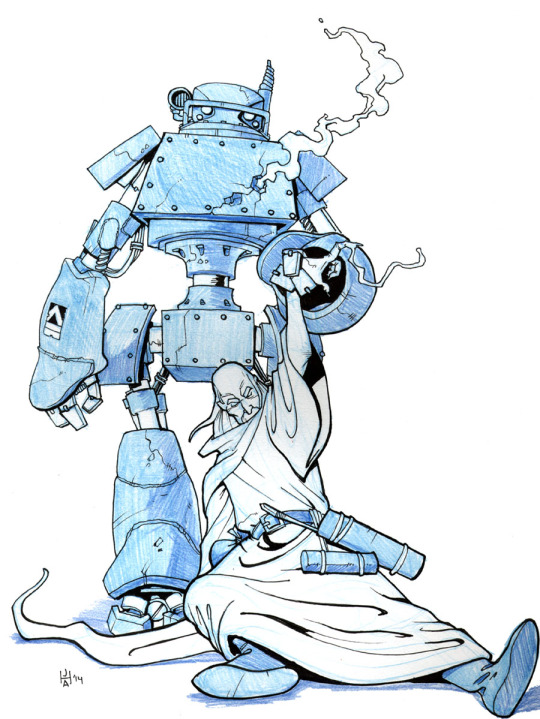
Was in a crummy mood and apparently drawing retro D&D robots makes me feel better.
Inevitables in D&D are ridiculously lawful neutral robot dudes who enforce kinda overall rules of the universe (don't just alter reality 'cause you can, don't murder the gods in a bid for immortality, that sort of thing - in the metagame sense, I figure they're intended as a plot widget and as a last-ditch way of reining in player characters).
Kolyarut inevitables hunt down oathbreakers, and really, I'm not gonna top Wayne Reynold's awesome Monster Manual painting, so I went in a totally different direction.
99 notes
·
View notes
Text
Creature Corner: Outsiders (Monitors) part 3

Foes
Just as monitors might align with the party, they might also align against them, particularly as their duty clashes with the goals of the party.
For aeons and inevitables in particular, the party might be part of some great imbalance or injustice, making them targets for such otherworldly threats. In the former case, the aeon may not bother to explain, or be utterly confusing in what communication it offers. In the latter the inevitable may never shut up, proclaiming their guilt if they fail to explain themselves or argue their case. Given that many inevitables are built to target specific types of lawbreakers, they might indeed be correct in their attempts to apprehend or slay one or more party members, or they might be mistaken.
Psychopomps, Shinigami, Valkyries, and marut inevitables all have a vested interest in protecting the sanctity of life and death, and as such, they might target a necromancy-wielding party member, or one that is currently benefiting from some unnatural method of preserving their life. Or, perhaps most horribly, the party stands between them and a group of people that have been marked for death for some fateful reason.
Creatures of whim, proteans are perhaps the most likely to turn on the party at the drop of a hat. This is not always the case, but if a protean is bored they might decide that it would be fun to cause mayhem at the party’s expense, especially if they are of a lawful persuasion.
Kami tend to keep to themselves, but adventurers that defile their ward or fail to show proper respect, or even are merely suspected of being in league with oni might be attacked.
Ennocites are varied, with caulborn being dangerous for not always asking permission before feeding on memories, shulsaga defending their territory like any other being, and the powerful adachros being dangerously insistent on their personal version of reality. Meanwhile, negative siktemporas and positive ones with conflicting interests might be aggressive.
Outside of broad categories, it is simply possible that there is a misunderstanding, that the party runs across a monitor on a mission that ends up with the monitor assuming they are in league with their target. The forces of the divine are hardly omniscient all the time, after all.
Consider also the possibility of monitors that have been corrupted by some external force as well, such as inevitables exposed to toxic algorhythms, or a psychopomp on the verge of falling and becoming a sakhil.
Conversely, perhaps the outsider is behaving normally, but its task is so terribly amoral that it will be incredibly hazardous to all involved, such as a kolyarut trying to fulfill an ancient pact regardless of whether that will cause widespread devastation by unleashing an ancient evil.
Even without such high stakes, sometimes monitors are set to guard something of great importance, forcing them into conflict with adventurers. The jyoti guarding the positive energy plane, inevitables guarding an artifact, and so on.
Monitors are hardly typical foes for your heroes, but not improbable, so it’s important to note how they might be used for such stories. That will do for today though. Tomorrow, we’ll look at some ways that these beings inspire and inform player characters!
7 notes
·
View notes
Text
Creature Corner: Outsiders (Monitors) part 2

Allies
Monitors follow their personal philosophy quite strongly, and when that philosophy aligns with the PCs, they can be quite useful allies. However, that very dedication can also make it difficult for the same reasons. An inevitable might agree that something must be done about a wicked king on the throne, but might refuse to aid them in a revolution, for example.
Even so, the fact that monitors are mostly predictable means that calling upon their aid can work out nicely as long as one’s goals are aligned.
The monitor type that is perhaps the most difficult to deal with would definitely be aeons. For one, while they can understand all languages, they only communicate in psychic images and impressions, when they deign to communicate their desires at all. For two, their mindsets, focused on the imbalanced duality they were created to correct. With that in mind, allying with aeons, or conjuring them to aid, is extremely difficult, as they do not negotiate, and have no interest in most treasures or payment. The only real way to do so is to know of an obvious imbalance that needs correcting, and hope the aeon agrees to the same.
By comparison, inevitables are much easier to deal with as each type of inevitable is literally built to protect some law or orderly concept, so if you have such a task that protects or serves that law, it’s simply a matter of finding or being powerful enough to call upon an inevitable focused on the law broken by the problem you wish to solve. Hunting an oathbreaker with a kolyarut, facing a lich with the might of a marut at your back, or even defeating a dishonorable warrior with a squadron of novenarut beside you. Such inevitables expect fair and honest bargaining, however, and are quick to punish deceivers.
Proteans can be quite flexible in the roles that they can be called to serve, which makes sense given their nature. However, they have to be tightly controlled, as while they might be amenable to performing any task, they have the ulterior motive to cause chaos, either performing any mischief they can manage within the confines of the magic that binds them, or by escaping that bond entirely and wreaking havoc. Of course, they type of havoc they cause could range from catastrophic to childish whimsy. As such, counting proteans as allies is a gamble, even when they’re fully on board with your desires.
Utterly driven by their duty to protect the cycle of life and death, psychopomps will potentially answer the call of anyone, as long as their goals align. Goals not having to do with the dead are likely to be ignored unless traded for a favor in protecting the cycle. However, those callers that wish for the psychopomps aid in destroying the undead, or correcting some perversion of the cycle will find negotiations much easier if the outsider deems the task worthy of their attention. However, it should be noted that psychopomps pursue their duty with no qualms concerning morality or method, so one must be careful that they don’t do something horrible in the pursuit of their goal.
As native outsiders, kami are not usually called for aid, but sought out and asked directly. However, most kami prefer to remain bodiless within their ward unless needed, so complex rituals honoring them may be required for them to take notice. Once you have their attention, a kami treated with respect may offer aid of some kind, either directly or indirectly if the need involves protecting nature and that which is sacred. They do have their wards, however, so such aid must not involve them travelling too far from their duty.
Ennocites and siktempora are poorly-understood outsiders, if they could be considered monitors at all, and as such are rarely called upon by mortals. More typically, one of these might ally with the party after meeting them, such as shulsaga working with mortals to fight threats to their home plane, caulborn seeking new and interesting memories, or various siktempora associated with positive emotions aiding heroes. To say nothing of individual outsider species offering aid, such a jyoti begrudgingly accepting help from mortal visitors, axiomites offering work, and so on.
Unlike celestials, the goal and duty-focused nature of most monitors means that gaining allies from them is considerably more situational, but nevertheless useful for those who can acquire their aid. However, it also means that one cannot always rely upon their help to succeed.
We’ve covered allies, but tomorrow, we’ll see what monitors are like as foes.
7 notes
·
View notes